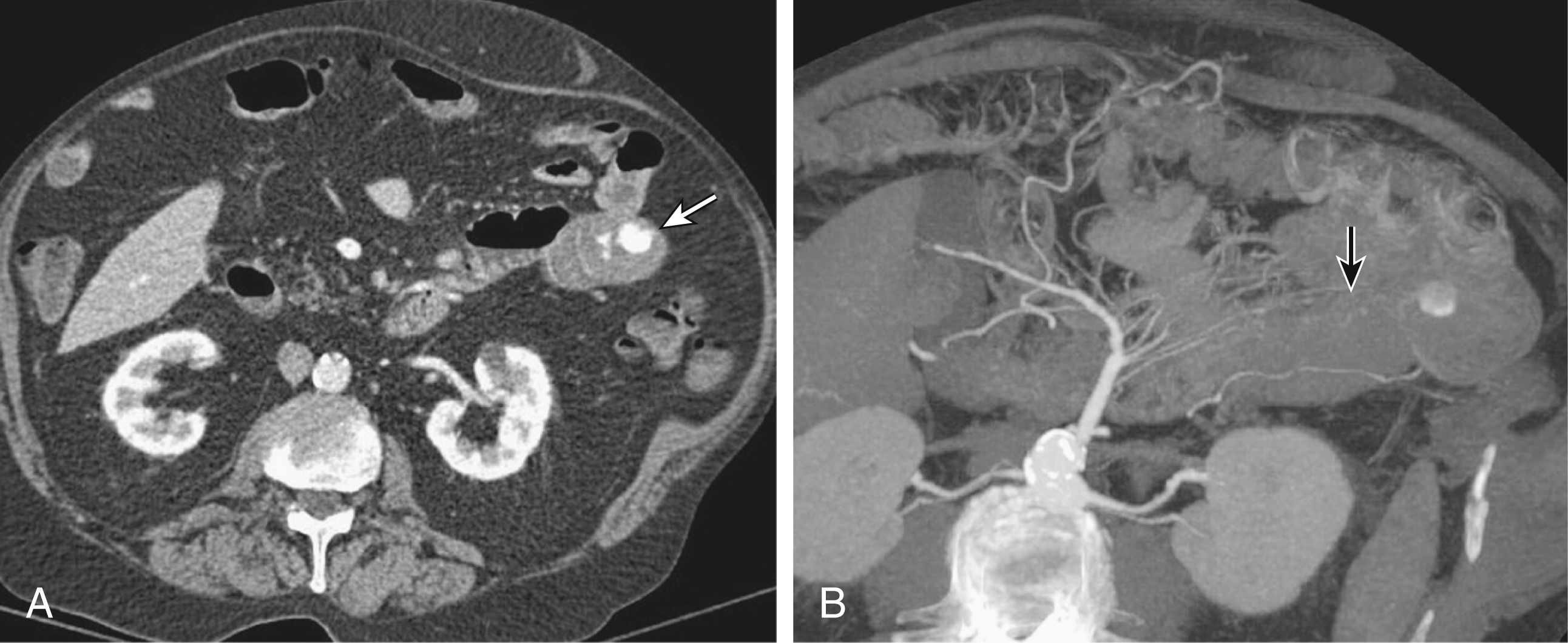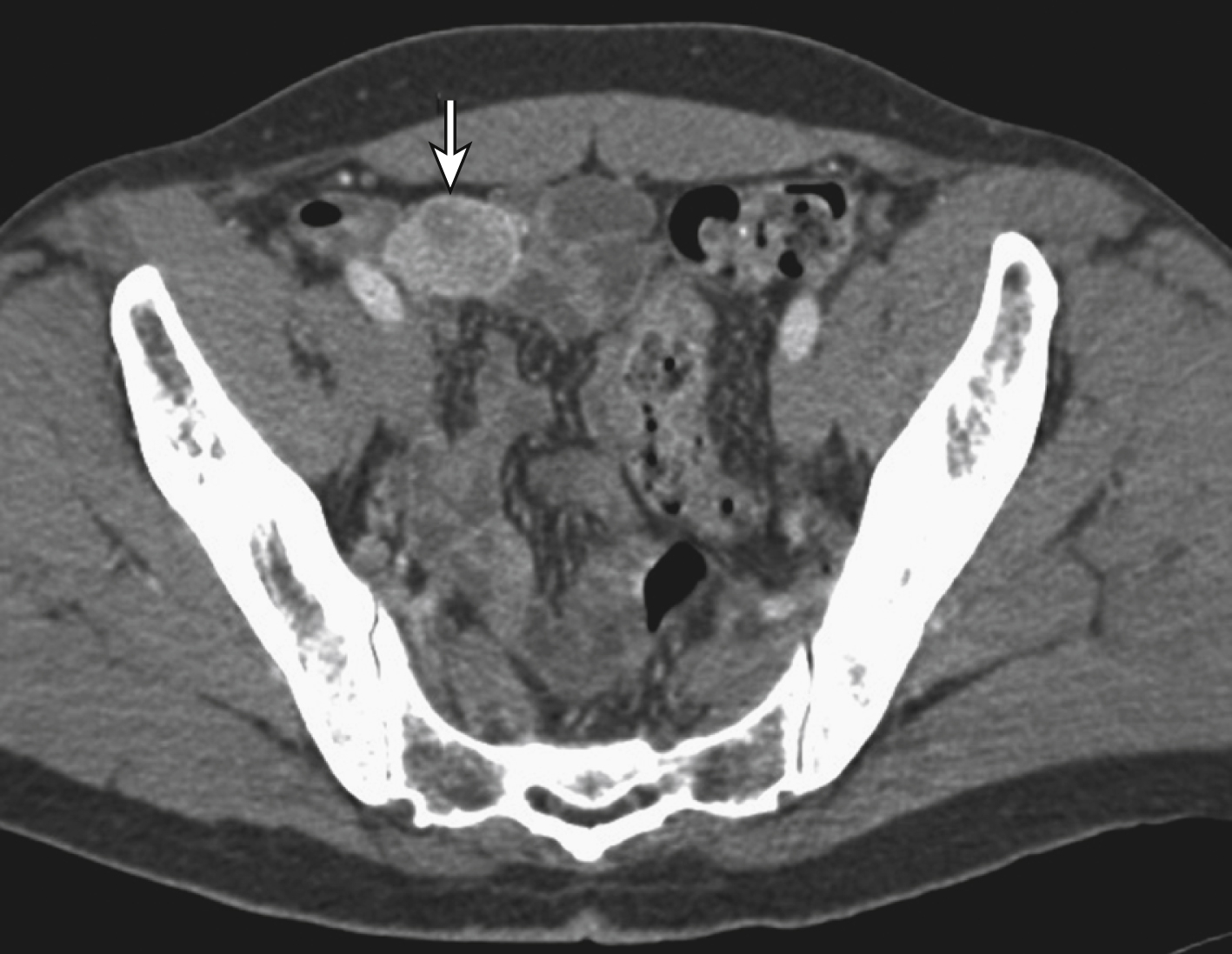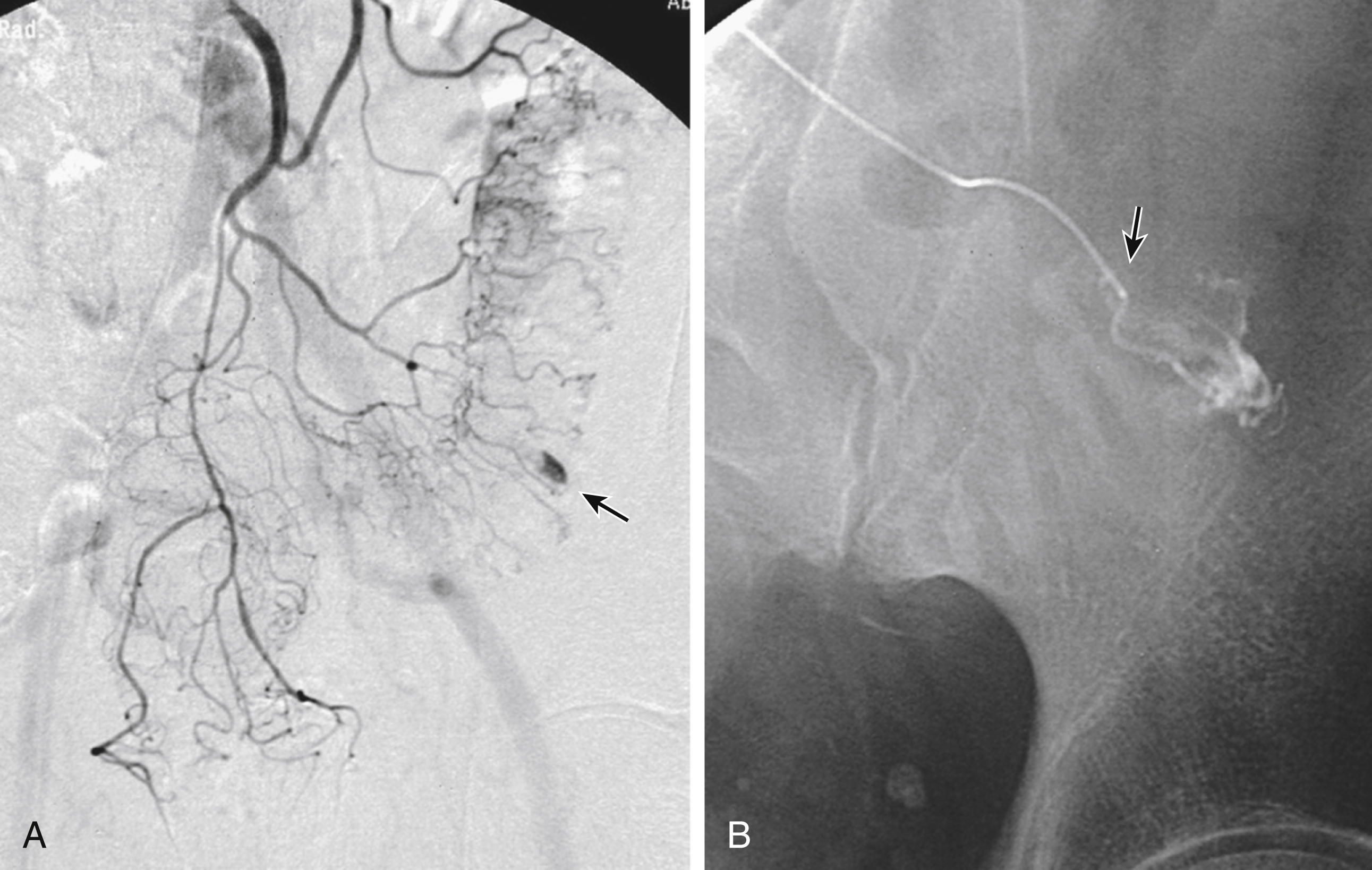Physical Address
304 North Cardinal St.
Dorchester Center, MA 02124
Lower gastrointestinal (GI) hemorrhage (LGIH) is much less common than upper GI tract hemorrhage. The incidence of LGIH is approximately 20.4 cases per 100,000 adults per year. However, it is associated with a 10% mortality rate, and although less common than upper GI bleeding, it more often demands the specialized skills of the interventional radiologist. These cases are frequently less amenable to endoscopic management, and many gastroenterologists will not attempt endoscopy while the patient is actively bleeding, owing to the difficulty in clearing blood and achieving visualization. Interventional techniques enable localization and control of hemorrhage more precisely and less invasively than surgery.
LGIH is frequently self-limited, so the first task is to determine whether the patient is bleeding actively enough to make it likely that catheter angiography (CA) will be positive. The actual output of blood is not always the best criterion. The patient may be bleeding internally, but does not have hematochezia because of the large holding capacity of the colon. Alternatively, bloody output from the rectum can continue long after bleeding has stopped as old blood is expelled. Although a high threshold for angiography increases the likelihood of a positive result, angiography should not be delayed until the patient is severely hypotensive. A patient manifesting hemorrhagic shock has already lost approximately 40% of their blood volume. The threshold for performing CA should also be modified by the patient’s cardiovascular and resuscitation history. An elderly patient with moderate cardiovascular disease may need a higher perfusion pressure to avoid end-organ ischemia and thus may poorly tolerate even mild hypotension. End-organ ischemia can also be exacerbated by the decreased oxygen-carrying capacity of blood hemodiluted by resuscitation fluids. In addition to clinical criteria such as hemodynamic derangement, decrease in hemoglobin, or transfusion requirements, radiologic studies may be helpful in selecting patients for CA. Computed tomographic angiography (CTA) and tagged red blood cell (TRBC) studies each have advantages and disadvantages in this role.
CTA has emerged as a rapid, cost-effective, and less invasive way to document and localize active bleeding. Although less sensitive than TRBC scans (the lower limit of detection is 0.4 mL/min for CTA vs. 0.1 to 0.35 mL/min for TRBC ), CTA is superior at localizing bleeding and diagnosing the underlying cause of hemorrhage. A review by Strate et al. that included 7 studies and 124 patients noted correct localization of bleeding in 100% of cases. CTA was shown to have 79% to 91% sensitivity, 85% to 99% specificity, and 91% to 98% accuracy for the detection of GI bleeding. Garcia-Blazquez et al. performed a metaanalysis and systematic review of the utility of CTA for GI bleeding. In aggregate, CTA had a sensitivity of 85.2% and a specificity of 92.1%, with positive and negative likelihood ratios of 10.8 and 0.16, respectively. More recent studies (with a higher proportion of high-resolution scanners) demonstrate even better results, with sensitivities of 95% to 100%, specificities of 96% to 100%, PPV of 95% to 100%, and NPV of 98.5% to 100%. ,
CTA outperforms TRBC scans in that CTA can define the bleeding pathology in 52% to 75% of cases. , This allows formulation of a therapeutic plan better tailored to the patient’s pathology ( Fig. e27.1 ). Another advantage of CTA is its ability to depict arterial anatomy ( Fig. 27.1 ). This should facilitate subsequent arterial catheterization and increase the ability to localize the bleeding site. In fact, exquisite depiction of arterial anatomy allowed one sigmoid diverticular bleed to be embolized empirically, which previously would never have been considered in the LGI tract. Practical advantages of CTA over TRBC scans are that they are generally more readily available and more rapidly performed.


TRBC scanning is more sensitive than CTA for LGIH and is 5 to 10 times more sensitive than angiography at detecting bleeding. However, a review of more than 600 TRBC scans showed that only 45% were positive. Thus a negative scan is still clinically useful because of its high sensitivity for active bleeding. A negative TRBC scan is useful at determining the advisability of an arteriogram. Although sensitive to the presence of bleeding (lower limit of detection is 0.1 mL/min 4 ), TRBC scans are less helpful for determining the location of bleeding. Zuckerman et al. noted that TRBC scans were falsely negative or provided incorrect localization in 3% to 59% of cases.
When patients with LGIH are massively bleeding and hypotensive despite resuscitative efforts, the decision to proceed directly to CA is fairly clear. Patients with large hemoglobin reduction, ongoing transfusion requirement, or hemodynamic alterations are much more likely to have positive imaging findings. Feingold et al. found that using pulse and blood pressure assessment alone was predictive of a positive TRBC scan. In this study 62% of unstable patients (defined as a heart rate greater than 100 or systolic blood pressure less than 100 mmHg) had a positive TRBC scan, but only 21% of the hemodynamically stable patients had positive scans. Similarly, an analysis of 88 patients showed three clinical factors that correlated with positive angiography. Angiograms were significantly more positive when blood pressure was less than 90 mmHg (87% positive vs. 12% positive when blood pressure was higher), transfusion requirements were 5 or more units of blood (84% vs. 15% for fewer transfused units), and hemoglobin dropped more than 5 g/dL from prior measurements (85% vs. 26% for lesser hemoglobin drops).
Jaeckle et al. reported similar findings for CTA: if SBP fell >20 mmHg or was <80 mmHg, or hemoglobin dropped by more than 3 points, or transfusion was necessary for hemorrhagic shock, CTA identified the location of hemorrhage in 92% of cases. Active extravasation was seen in 83% of cases. Because many LGIHs are intermittent, the shorter the time from CTA to CA, the more likely CA will be positive. Tan et al. showed that the likelihood of a positive CA study was nearly three times as much if CA was performed within 150 minutes of a positive CTA. Similarly, Koh et al. found that a positive CA study was 8.5 times more likely after a positive CTA if it was performed within 90 minutes.
Even for patients selected for CA based on clinical status, preprocedural imaging (particularly CTA) can still provide valuable information regarding the location of the hemorrhage and potential diagnoses. Additional benefits include potentially shortening CA procedure time and informing postangiography management. Jacovides et al. showed that compared to TRBC scanning, CTA significantly reduced the number of overall imaging studies needed in hospital. Although CTA was associated with greater overall contrast volumes for patients undergoing CA, there was no concomitant increase in renal dysfunction.
When uncertainty exists about whether a patient is actively bleeding, the decision to proceed to CA is less straightforward. In these cases, CTA or TRBC scan may be useful to select patients for CA. The likelihood of a positive CTA is much lower for hemodynamically stable patients compared with those who are hemodynamic stable. In a study by Chan et al. 77.4% of patients with LGIH and a negative CTA had no recurrence of hemorrhage with medical treatment alone. Foley et al. demonstrated in a small case series that bleeding in hemodynamically stable patients with LGIH ceased spontaneously in 90% of cases. They also found that 90% of patients with negative CTA, regardless of hemodynamic status, did not require intervention.
Although generally reserved for acute active bleeding, CA can occasionally be useful in patients with chronic low-grade bleeding in whom multiple endoscopies and other tests have failed to yield the diagnosis. Rollins et al. reported that in patients with chronic LGIH, CA revealed either structural lesions that could account for the bleeding or actual extravasation in 44% of their patients.
Many of the contraindications to elective CA become relative contraindications when weighed against the need to manage life-threatening bleeding. Direct discussion about these risks and possible benefits should occur during the informed-consent process. History of a life-threatening contrast allergy is a fairly firm contraindication to immediate angiography. Time can be taken to pretreat with steroids if bleeding is not massive, but the magnitude of the reaction must be weighed against the risk of exsanguination in each individual case. Input and assistance from anesthesia may also be sought in these cases. Similarly, the risk of renal failure in patients with preexisting renal insufficiency must be balanced against the need for possible life-saving embolization. Vigorous intravenous hydration can be started to reduce the risk of contrast nephropathy while monitoring the patient’s cardiopulmonary status to avoid fluid overload and pulmonary edema.
Coagulopathy is a relative contraindication because it increases the risk of access site bleeding. Even with severe coagulopathy, CA can still be done with a plan to leave a sheath in the arterial access site until the coagulopathy has been corrected. The sheath can also be used to continuously monitor arterial pressure in the postprocedure period. Alternatively, closure devices can be used to effectively manage the arteriotomy. Another reason coagulopathy is a relative contraindication is that it significantly lowers the efficacy of embolization. Although emboli reduce blood flow, complete cessation of flow requires formation of some thrombus around the emboli when using microcoils or polyvinyl alcohol.
Equipment commonly used in LGIH procedures is listed in Table 27.1 .
| Equipment | Options / Examples | Manufacturer |
|---|---|---|
| 6Fr Sheath | Multiple versions | Multiple options |
| 5Fr Catheter for SMA | SOS Omni | Angiodynamics, Queensbury, NY |
| Cobra | Multiple options | |
| Lev 1 | Cook Inc., Bloomington, IN | |
| 5Fr Catheter for IMA | RIM | Cook Inc., Bloomington, IN |
| Rarely, SOS or Cobra | See above | |
| 3Fr Microcatheter | Progreat | Terumo Medical Inc., Somerset, NJ |
| Mass Transit | Cordis, Miami, FL | |
| Wire for microcatheter | Glidewire GT | Terumo Medical Inc., Somerset, NJ |
| Transcend | Boston Scientific, Miami, FL | |
| Embolic agents | Microcoils | Multiple options |
| 0.025 in Glidewire to push microcoils | Boston Scientific, Natick, MA | |
| PVA (>300 micron) | Multiple options |
After accessing the femoral artery, a sheath with a hemostatic valve is deployed. Although the primary role of the sheath is to ensure that arterial access can be maintained throughout the embolization procedure, it also facilitates catheter exchanges. Emboli can become lodged inside the angiographic catheter lumen so tightly that even a guidewire will not pass. If the occluded catheter was introduced through a sheath, it can be safely removed without loss of arterial access.
Angiographic catheters needed to catheterize the mesenteric vessels come in a variety of configurations. Although the catheter used is often a matter of personal preference, certain shapes are more favorable for specific vessels. A recurved catheter like a SOS (Angiodynamics, Queensbury, NY) or Simmons will work well for a caudally directed celiac or superior mesenteric artery (SMA). If the vessel origin comes off at a right angle or is even directed cephalad, then a less curved Cobra or Lev 1 (Cook Inc., Bloomington, IN) catheter will work better. The inferior mesenteric artery (IMA) generally leaves the aorta in a steep caudal direction. That plus the smaller size of the aorta at this level makes the shape of a Rösch inferior mesenteric catheter (Cook Inc., Bloomington, IN) most appropriate for the IMA.
Angiographic catheters are intended to engage just the proximal part of the mesenteric artery, which suffices for initial diagnostic angiography. If bleeding is identified, these catheters are suitable for therapy only if the plan is to infuse vasopressin into the main trunk of the artery. The bleeding focus is usually in the periphery of the vessel distribution, so if embolization is planned, superselective catheterization is required. A 2.4, 2.7, or 2.8F microcatheter introduced coaxially through the 5F angiographic catheter is the tool of choice. There are now even smaller microcatheters available with distal tips with an outer diameter as small as 1.7F. Modern microcatheters are extremely flexible and are often coated to decrease friction. This allows them to be advanced all the way out into the vasa recta in the bowel wall ( Fig. e27.2 ). It is this ability to do superselective catheterization that has revolutionized the interventional treatment of LGIH, because superselective catheter placement markedly improves the safety of embolization.

Become a Clinical Tree membership for Full access and enjoy Unlimited articles
If you are a member. Log in here